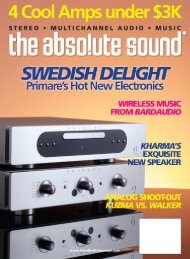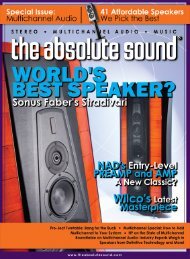Contents
Contents
Contents
You also want an ePaper? Increase the reach of your titles
YUMPU automatically turns print PDFs into web optimized ePapers that Google loves.
Editor<br />
FROM THE<br />
“The next<br />
step is a series<br />
of conference<br />
calls among the<br />
magazine’s senior<br />
editorial staff in<br />
which we discuss,<br />
debate, argue,<br />
cajole, and hash<br />
out whether or<br />
not a product<br />
should be added<br />
to the Editors’<br />
Choice list.”<br />
We’re pleased to unveil in this issue the new graphic direction for The Absolute Sound. We think you’ll<br />
find that our look is fresher and more stimulating—and makes what we have to say more accessible.<br />
The design was created by Art Director, Torquil Dewar, who will be putting together each issue of<br />
the magazine in the future.<br />
We’ve also just given our sister magazine, The Perfect Vision, an editorial and graphic update. Concomitantly,<br />
we’ve increased the publication frequency of TPV to ten times per year (up from six) and are offering the<br />
magazine in electronic form absolutely free at www.avguide.com.<br />
While you’re at avguide.com, be sure to join our reader forum and get in on the discussion with other<br />
readers and TAS editors. Jonathan Valin’s review of the $22,000 MAGICO Mini in the last issue sparked quite<br />
a controversy on the forum over the concept of value in high-end audio. Read Jonathan’s insightful ideas and<br />
contribute your own thoughts on the avguide.com forum.<br />
This issue features our 35-page Editors’ Choice list of every product we recommend. We determine the final list<br />
by taking last year’s recommendations, removing discontinued products, and then considering for inclusion every<br />
component we’ve reviewed in the current year. We poll the writers who wrote the reviews, asking whether they<br />
would buy the products themselves with their own money. The next step is a series of conference calls among the<br />
magazine’s senior editorial staff in which we discuss, debate, argue, cajole, and hash out whether or not a product<br />
should be given an Editors’ Choice Award.<br />
To call these conference calls “lively” would be an understatement. There’s heated—though always congenial—<br />
debate about whether certain products should be included. An important criterion is whether the candidate<br />
product is equal to, or better than, a similarly priced product. If the answer is no, the product doesn’t make the<br />
final cut. In some cases, however, we allow for differences in design, such as stand-mounted vs. floorstanding<br />
loudspeakers, or tubed vs. solid-state amplifiers. Of course, some products are so outstandingly good that we<br />
reach unanimous agreement immediately. We also consider whether an idiosyncratic product that perhaps isn’t<br />
our cup of tea would, nonetheless, perform well in certain systems. We’ll include some such products, but point<br />
out in the write-ups that they fit into very narrow niches.<br />
Our Editors’ Choice list is the single biggest feature we publish all year. It represents the collective wisdom<br />
and experience of our writers and editors. Not every product worthy of recommendation is on the list (we don’t<br />
recommend what we have not heard), but every product on the list is worthy of recommendation.<br />
I was having dinner with Bob Carver in Austin, Texas, the other night when a funny thing happened. As you<br />
probably know, Carver is the founder of Carver, and more recently, of Sunfire. He is one of the few truly<br />
innovative thinkers in audio design. Many designers have created great-sounding circuits, but very few have<br />
invented entirely new circuit topologies (and loudspeaker concepts) from a clean sheet of paper.<br />
Carver’s innovations include the first high-powered solid-state amplifier (the 350Wpc Phase Linear 700 in<br />
1972), the Auto-Correlator circuit, Sonic Holography, the Magnetic-Field Power Amplifier, and the Asymmetric<br />
Charge-Coupled Stereo Detector, a circuit for improving FM reception. Carver’s ingenuity extends to<br />
loudspeakers, as well. His Amazing Loudspeaker, introduced in 1986, employed a 60-inch ribbon with four 12-<br />
inch woofers in a large, open panel. When set up correctly, the Amazing lived up to its name. In addition, before<br />
Carver developed his True Subwoofer in 1994, you simply couldn’t get low bass from a small box, but the True<br />
Subwoofer delivered extremely high levels of very low bass from an enclosure about a foot square. It was nothing<br />
short of revolutionary.<br />
Anyway, back to my dinner story. The young waiter overheard us talking and asked incredulously, “You’re Bob<br />
Carver” Bob modestly replied that he was. After dinner, another waiter, who must have been about 22 years old,<br />
approached the table and told Bob that his father owns the pair of Phase Linear 700s that he bought in 1972, and<br />
is still listening to music on them to this day.<br />
How gratifying it must be to know that something you created 34 years ago is still being enjoyed in the here<br />
and now—and to be recognized by a generation who wasn’t even born when some of your creations were<br />
developed.<br />
It was a wonderful moment.<br />
10 October 2006 The Absolute Sound<br />
Robert Harley<br />
Editor-in-Chief










